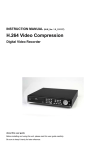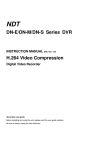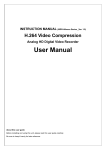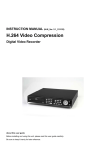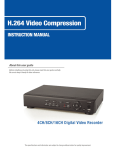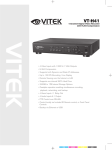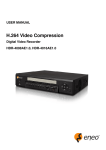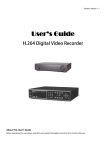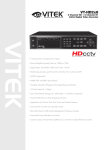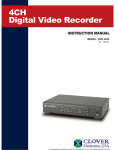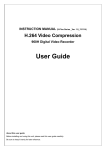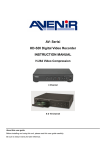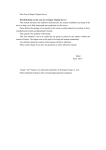Download H.264 Video Compression
Transcript
INSTRUCTION MANUAL (M_Ver. 1.2_HD(20101007) H.264 Video Compression Digital Video Recorder About this user guide Before installing and using this unit, please read this user guide carefully. Be sure to keep it handy for later reference. Safety Precautions Explanation of Graphical Symbols This symbol indicates the presence of important operating and maintenance (servicing) instructions in the literature accompanying the product. This symbol indicates the presence of uninsulated ”dangerous voltage” within the product’s enclosure that may be of sufficient magnitude to constitute a risk of electric shock to persons. WARNING To reduce a risk of fire or electric shock, do not expose this product to rain or moisture. CAUTION Changes or modifications not expressly approved by the manufacturer may void the user’s authority to operate this equipment. CAUTION Danger of explosion if battery is incorrectly replaced. Replace only with the same or equivalent type recommended by the manufacturer. Discard used batteries according to the manufacturer’s instructions. 2 These precautions must be followed for safety reasons. Warning Do not use if the unit emits smoke, strange sounds are heard, or odor is emitted. Make sure the power cable is not damaged. Make sure there is no dust accumulation on the power plug or the outlet. Disassembly prohibited Do not place any foreign objects inside the unit. Do not place a container holding water or other liquids above the unit when it is connected to power. Do not allow the unit to get wet. Do not use during thunder/thunder storms. Do not place in an unstable position. Do not expose to shock or vibration. Do not use this unit in areas where it is exposed to the possibility of explosion. Caution Do not pull on the power cable when removing the power plug from the outlet. Do not touch the power plug with wet hands. Do not sit on. Make sure the cables are connected properly. Do not place heavy objects on connected units. Never move this unit while the power is turned on. Remove the power plug from the outlet when the unit is going to remain unused for long periods of time. Do not block the cooling fans or air ducts. Do not expose to extreme temperatures or humidity changes. The Socket Outlet shall be installed near the equipment and shall be easily accessible 3 Warning Installation and servicing should be performed only by qualified and experienced personnel. Turn off the power of the DVR when connecting cameras, audio or sensor cables. The manufacturer is not responsible for any damage caused by improper use of the product or failure to follow instructions for the product. The manufacturer is not responsible for any problems caused by or resulting from the user physically opening the DVR for examination or attempting to fix the unit. The manufacturer may not be held liable for any issues with the unit if the warranty seal is removed. Product Components The package contains the main unit and its components as specified below. When you purchase the unit, Please check to ensure the components specified below are included. DVR Set Client Software CD Remote Control Battery1.5V (AAA x 2EA) User Guide HDD data cable HDD mounting bracket & Screw HDD fixing screw Items 4CH HD DVR Basic version HDD data cable 4EA HDD mounting bracket 4EA HDD Mounting bracket screw 4EA HDD/DVD-RW fixing screw 16 EA 4 Basic function of the MOUSE ①: Left button: SELECT function ②: Right button: Go to Sub Menu ① : Double click: Change Full Screen or Split Screen Mounting the HARD DISK 1. Unfasten the cover of the unit. 2. Fix the supplied HDD mounting bracket to the hard disk using the supplied mounting bracket screws. 5 3. Insert the HDD bracket to the hole and fix the screw. 4. Connect the supplied SATA cable and power cable to the hard disk. NOTE) HDD should be connected in order from HDD1/ODD, HDD3, HDD4, HDD5, HDD6, HDD7, HDD8. If HDD is connected like HDD1/ODD, HDD4 as skipping HDD3 connector if not DVR may malfunction. 6 Available Model and Max. Recording Speed Recording Speed (Maximum) Model HD 720p(1280x720) HD-0410S(4CH) 120fps Specification ITEM Specification Channel Input Level 4CH HD-SDI (720p25/30/50/60) Video Loss Check YES Main Monitor Output HDMI (1280x720) Sub Monitor Output VGA (1280x1024) Spot CVBS Input Video Output Input 4 RCA Output 1 RCA Audio Codec G.711 Sensor Input 4CH, NC/NO Selectable Alarm Out 1CH out by Sensor, Motion and Video Loss POS RS-232C PTZ RS-485 Controller RS-485 Network Ethernet RJ-45, 10/100/1000Base-T, Auto MDI/MDIX Operation PentaPlex Live/Record/Playback/Backup/Network Digital Zoom Selected Area Maximize Channel Sequence 3 ~ 60 seconds Auto Compression H.264 Resolution 1280x720 / 640x360 selectable per channel Recoding Quality Grade 4 Levels Recording Mode Continuous, Schedule, Motion, Sensor, Manual Motion Detection Setup by Grid Pre Recording Min. 15 seconds and Max. 20 minutes Post Recording 10 ~ 30 seconds Digital Zoom Zoom-in of specific area Audio Alarm Serial Live Recording Playback FF x1/4, x1/2, x2, x4, x16 and x32 FR x2, x4, x16 and x32 Speed Search Mode Timeline, Event, Archive, Log, Specific Time 7 Backup File Format JPEG/Proprietary Format Media USB/External HDD/Network Built-in Viewer Yes Dual Streaming for Live H.264 CIF 120fps Playback H.264 HD 30fps Streaming RTP/RTSP/RTCP Protocols HTTP, DDNS, NTP, SMTP Network HDD Storage Interface SATA, e-SATA Max. Capacity of HDD 2TB Max. Internal HDDs 4EA External Storage 1 e-SATA Filesystem Self-developed, Reliable and Stable Filesystem Raid Yes (TBD) SMART HDD Error Check and Reporting Menu Display Graphic User Interface Input Method Mouse, Remote Controller and Keypad PC Client Live, Search/Playback, Backup, PTZF Camera Control Web Viewer Live, Search/Playback, Backup, PTZF Camera Control DST (Daylight Saving Time) Yes Internal Beep By Alarm, Motion, Video Loss, HDD Error Multi Language Yes Software Upgrade By USB, Network Remote Upgrade (TBD) NTP (Network Time Protocol) Yes Watermarking Yes (TBD) 3G Mobile iPhone, Blackberry Remote Setup Yes Operation Condition 0~40C, Humidity 20~80% Power AC 100~127V/200~240V, 5~60Hz, 280W Net Weight (Gross Weight) 6KGS (9.5KGS) / 13.2LBS (20.9LBS) Unit Dimension (W x D x H) 417mm x 432mm x 99mm / 16.4" x 17" x 3.9" User Interface Network Access Features General Specifications are subject to change without notice 8 Table of Contents 1. Name, Function and Connection........................................................................................ 11 1-1. Front Panel................................................................................................................................... 11 1-2. Rear Panel ................................................................................................................................... 13 1-3. Remote control ............................................................................................................................. 14 2. Setting up the DVR ............................................................................................................ 15 2-1. Setup – Main Screen .................................................................................................................... 15 2-2. Setup – Display Mode .................................................................................................................. 18 2-3. Setup – Recording Mode .............................................................................................................. 19 2-3-1. Recording Schedules ................................................................................................................ 20 2-4. Setup – Device Mode ................................................................................................................... 21 2-4-1. ALARM-OUT ............................................................................................................................. 23 2-4-2 PTZ Setup .................................................................................................................................. 23 2-4-3. Motion Zone Setup .................................................................................................................... 24 2-5. Setup – Storage Mode .................................................................................................................. 25 2-6. Setup – System Mode .................................................................................................................. 26 2-7. Setup – SECURITY Mode ............................................................................................................ 28 2-8. Setup – Network Mode ................................................................................................................. 29 2-8-1. Ports.......................................................................................................................................... 30 2-8-2. Network Types .......................................................................................................................... 31 2-8-2-1.STATIC.................................................................................................................................... 31 2-8-2-2. DHCP..................................................................................................................................... 32 2-9. Setup - CONFIG Mode ................................................................................................................. 33 3. Saving Setup ..................................................................................................................... 34 4. Live, Search, and Playback ............................................................................................... 34 4-1. Live Viewing Screen ..................................................................................................................... 34 4-2. SEARCH Screen .......................................................................................................................... 36 4-2-1. TIME-LINE Search .................................................................................................................... 37 4-2-2. Event Search............................................................................................................................. 38 4-2-3. Go To First Time ........................................................................................................................ 38 4-2-4. Go To Last Time ........................................................................................................................ 38 4-2-5. Go To Specific Time ................................................................................................................... 39 4-2-6. Log Search ................................................................................................................................ 39 4-2-7. Archive Search .......................................................................................................................... 39 4-3. Play mode .................................................................................................................................... 39 5. PTZ Control ....................................................................................................................... 40 6. Back up ............................................................................................................................. 42 9 6-1. Still Image backup onto USB flash memory .................................................................................. 42 6-2. Video backup onto USB flash memory ......................................................................................... 43 6-3. Transferring still images or video from the ARCHIVE list .............................................................. 43 6-4. Playback of Backup Video ............................................................................................................ 43 7. Upgrading Firmware .......................................................................................................... 44 8. Network access using the UMS Single viewer ................................................................... 45 8-1. PC requirements .......................................................................................................................... 45 8-2. Installing the network viewer ......................................................................................................... 45 8-3. Live monitoring mode and functions. ............................................................................................ 46 8-4. Bi directional audio ....................................................................................................................... 48 8-5. Remote search mode and functions ............................................................................................. 49 8-6. PC System configuration .............................................................................................................. 52 9. Network access using the UMS Multi Software .................................................................. 54 9-1. Installing the program ................................................................................................................... 54 9-2. Live Window ................................................................................................................................. 55 9-3. Search and Playback Window. ..................................................................................................... 58 9-4. Setup of UMS Multi Client............................................................................................................. 61 9-5. Remote Setup .............................................................................................................................. 65 9-6. Operation ..................................................................................................................................... 75 10. Network – By an web-browser viewer ................................................................................ 86 APPENDIX: How to connect network........................................................................................ 87 A. How to set IP address of the DVR and open TCP port of the router?............................................ 87 B. How to access DVR from Remote PC? ........................................................................................ 90 10 1. Name, Function and Connection 1-1. Front Panel The following information will help you to operate the front panel controls. Figure 2.1.1. Front panel Table2.1.1. Indication lamps Name POWER HDD Description LED light is on when power is applied to the system. Green – Power On, Orange – Power Off LED light is on when the system is recording video data. ALARM LED light is on when alarm sensor(s) is/are triggered or motion is detected. NETWORK LED light is on when client is connected to the system through the network. CH1, 2, 3, 4 LED light is on when the channel is recorded. Table 2.1.2. Front panel buttons Name DISPLAY SEQ AUDIO Description Press to toggle the screen mode. (Full or Quad) Press to start auto sequencing of the screen in full screen mode. (Toggle) Press to set the audio output mode. (Mute, 1CH to 4CH) PTZ Press to control PTZ operation SETUP Press to launch SETUP menu. ALARM Press to set the alarm output mode. (On or Off) BACKUP SEARCH Press to start operations involving archiving in live or playback mode. Press to go to the search menu. Event search /Time line search /Log /Archive search 11 ESC Press for temporal storage of the changed value or to return to previous menu screen. Press to move up the menu items in setup mode and to select camera 1 in live mode. It is also used as the number 1 when entering password. Press to move right in the menu or to change the values in setup mode and to select. camera 2 in live mode. It is also used as the number 2 when entering password. Press to move down the menu items in setup mode and to select camera 3 in live mode. It is also used as the number 3 when entering password. Press to move left in the menu or to change the values in setup mode and to select camera 4 in live mode. It is also used as the number 4 when entering password. Press to select full screen or quad view in live display mode. It is also used to select desired menu item or to store the setup value in the menu. PLAY/PAUSE Press to play or to pause the footage in playback mode Press to rewind the footage at 1x, 2x, 4x, 8x, 16x and 32x speed in playback mode. Jump/Step backward. – In playback mode, the playback position moves 60 seconds backward. Jump/Step forward – In playback mode, the playback position moves 60 seconds forward. Press to fast forward the footage at 1x, 2x, 4x, 8x, 16x and 32x speeds in playback mode. Press to start MANUAL RECORDING There is a USB port located on the left side of the front panel. This USB port is USB port used to archive footage into a USB storage device or mouse control. (USB 2.0 connector) NUM KEY CH1, 2, 3, 4 Channel selection button. 12 1-2. Rear Panel Figure 2.2.1. Rear Panel Table 2.2.1. Rear panel connections NO Connection Purpose 1 VIDEO IN 4 BNC connectors for video input. (HD-SDI) 2 AUDIO IN 4 connectors for audio input. 3 AUDIO OUT 1 connector for audio output. 4 VIDEO OUT Spot output (To be supported) 5 VGA 6 RS-232 Connector for VGA monitor. POS Interface (TBD). 13 7 HDMI OUT Main Video Output (1280x720P) 8 USB Port Connector for Mouse or Backup 9 RSV Reserved PIN for additional feature D1+ 1st RS-485 port D2+ 2nd RS-485 port A1, B1 SENSOR IN 10 TERMINATE UNIT ID 11 ETHERNET 12 E-SATA Alarm Output Connector for Alarm Device 4 connectors for sensor device connection. (S1 ~ S4) RS-485 termination switch for 1st and 2nd. Reserve PIN for additional feature RJ-45 connector for network function To archive still-image or video into a External Storage HDD . RAID Units to be available in the future 13 Input Voltage 14 POWER SOCKET Select input voltage according to local electricity standard Connect for AC110V~250V 1-3. Remote control RECORD Manual recording DISPLAY Display of Full, Quad,9 or 16 split screen F/REW Jump 60 seconds backward PLAY/PAUSE Play/Pause F/ADV Jump 60 seconds forward REW Rewind BACKUP Backup still or video data FF Fast Forward ALARM Disable alarm operation SETUP Setup menu screen ID DVR ID (ID Button + DVR ID number) AUDIO Mute, Single(1CH), MIX(4CH) LOCK Lock all of key functions SEQ Sequence of Full or Quad view PTZ PTZ menu screen SEARCH Search menu screen DIRECTION KEY Direction key SELECT Select or display of split screen ESC Esc 14 NUMBER 1~9,0 Channel 1 to 9 / 10CH->press 0 +10 Channel 11 to16 11CH->press +10 and number 1 16CH->press +10 and number 6 2. Setting up the DVR The following sections detail the initial setup of a DVR. 2-1. Setup – Main Screen To enter the setup menu, select MENU and SETUP on the screen using the mouse or press the SETUP 15 button on the front panel. Then select a user type. User can select one of user types (ADMIN, USER1, USER2, USER3) using the control button (◀ ▲ ▶ ▼) on the front panel and press SEL button. Input the password by front key panel, mouse or remote controller. Use the Virtual Keyboard when you use front key and mouse. The factory default password is 1111. It is highly recommended to assign a new password to protect the system. User can assign a new password in SECURITY setup menu. Table 2.1.1. Setup menu tree DISPLAY – OSD – OSD CONTRAST 16 – SEQUENCE – SEQ-DWELL TIME – CHANNEL - RECORD – CHANNEL - FRAME RATE - QUALITY - RECORDING - SENSOR RECORDING - PRE RECORD - POST EVENT RECORD - AUDIO - SCHEDULE - RESULUTION DEVICE – ALARM OUT – PTZ – CHANNEL - MOTION ZONE - MOTION SENSITIVITY – KEY TONE – REMOTE CONTROL ID – SENSOR - TYPE STORAGE – OVERWRITE – DISK FORMAT – DISK INFO – RECORDING LIMIT - NAME RECORDING LIMIT DAYS SYSTEM – DVR-ID – DESCRIPTION – LANGUAGE – DATE FORMAT – SET DATE & TIME – CLIENT ACCESS – BANDWIDTH SAVING 17 – NTP – SEND EMAIL SECURITY – USER AUTHENTICATION – USER PASSOWRD NETWORK – PORT – WEB PORT – NETWORK TYPE (DHCP, STATIC) – DDNS CONFIG – SAVE SETUP TO A USB – LOAD SETUP FROM A USB – LOAD DEFAULT – LOAD FACTORY DEFAULT 2-2. Setup – Display Mode Press the SETUP button and enter the password. The setup menu is displayed as picture below. Select DISPLAY icon and press SEL button to enter the setup menu item. Navigate through the menu items using the control button (◀ ▲ ▶ ▼) and change the value of the menu item using the control button (◀ ▲ ▶ ▼). To return to setup menu screen, press the ESC button. Figure 2.2.1. Display mode setup screen Table 2.2.1. Menu items in DISPLAY mode setup Item OSD Description Enable/disable on-screen-display. Select ON: show it on the screen, Select OFF: Disappear on the screen. SEQUENCE SEQ-DWELL TIME Enable/disable sequential display of video in full screen mode. Set the dwell time of each, single channel display in sequential display 18 mode (HD-0410S) (3~60seconds) Quad or 9 channels display in sequential display mode.(1-60seconds) (HD-0810S, HD-1610S) (1~60seconds) OSD CONTRAST CHANNEL Set the visibility level of the On Screen Display (OSD).(0-100) Select a channel for applying the following settings using the control button (◀ ▲ ▶ ▼). Press SEL button to change the channel. NAME Set the channel name. Press SEL button and set the channel name and select OK using the control button (◀ ▲ ▶ ▼). 2-3. Setup – Recording Mode Press the SETUP button and enter the password. The setup menu is displayed as picture below. Select RECORD icon and press SEL button to enter the setup menu item. Navigate through the menu items using the control button (◀ ▲ ▶ ▼) and change the value of the menu item using the control button (◀ ▲ ▶ ▼). To return to setup menu screen, press the ESC button. Figure 2.3.1. Recording mode setup screen Table 2.3.1. Menu items in Recording mode setup Menu item Description CHANNEL Select a channel for applying the following settings using the control button (◀ ▲ ▶ ▼). Press SEL button to change the setting value of all channels at once. Once you select an item, then press SEL to set value for all channels. Use virtual keyboard for all setting on one screen as you want as bellow picture. 19 FRAME RATE Set the frame rate for the specified channel. The sum of the frame rate values from each channel cannot exceed the maximum frame rates for a specific recording resolution. Typical values of the maximum frame rate for video are 120/100 fps QUALITY Select the recording quality for the specified channel. Options are: Economy, Standard, High and Super. RECORDING Assign the recording mode for each channel. Options are: Continuous, By Motion, By Sensor, By Schedule or Disable. SENSOR Enable setting up to 4 sensors for the specified channel using the RECORDING control button (◀ ▲ ▶ ▼). PRE RECORD Enable/disable pre-event recording. Pre-event recording time is 15 seconds to 20 minutes(Selectable) POST EVENT RECORD AUDIO Set the post event recording time duration for the specified channel. (10-30 seconds) Enable/disable audio recording for the specified channel. Fixed-available on only from channel 1 to channel 4. SCHEDULE Set the recording schedule. Press SEL to go to schedule setup screen. RESOLUTION Set the resolution to 1280X720, 640X360 2-3-1. Recording Schedules To setup a recording schedule, select SCHEDULE in the RECORD menu. Navigate through the items using the control button (◀ ▲ ▶ ▼). Once the channel 1 is selected, SCHEDULE-CH1 screen is displayed. Select ALL or each day using the control button (◀ ▲ ▶ ▼) and set the recording mode using the SEL button repeatedly 20 . Figure 2.3.2. Schedule recording setup screen C: CONTINUOUS recording, When you select the color will change to Blue Color M: MOTION recording, When you select the color will change to Yellow Color S: SENSOR recording, When you select the color will change to Red Color -: Does not record [ALL]: Move the cursor to ALL and select a recording mode C,M or S using the SEL button to set the same setting for every day. [SUN to SAT]: Move the cursor to SUN to SAT and select a recording mode C,M or S using the SEL button to set the same setting for the whole day. [Vertical Bar “ | “]: Move the cursor to ALL and move the cursor to the specific time using the control button (◀ ▲ ▶ ▼). And select a recording mode C,M or S using the SEL button to set the same setting. [SEL]: The recording mode can be selected by pressing repeatedly the SEL button. [COPY FROM] [COPY TO]: Set the channel 1 schedule and select COPY TO using the control button (◀ ▲ ▶ ▼), select CH2 using the control button (◀ ▲ ▶ ▼) and press the SEL button. Then the CH1 schedule is copied to CH2. To return to setup menu screen, press the ESC button. 2-4. Setup – Device Mode Press the SETUP button and enter the password. The setup menu is displayed as picture below. Select DEVICE icon and press SEL button to enter the setup menu item. Navigate through the menu items using the control button (◀ ▲ ▶ ▼) and change the value of the menu item using the control button (◀ ▲ ▶ ▼).To return to setup menu screen, press the ESC button. 21 Figure 2.4.1. Device mode setup screen Table 3.4.1. Menu items in Device Setup screen Item ALARM OUT PTZ CHANNEL MOTION ZONE MOTION SENSITIVITY Description Set the sensor, motion, and video loss for each alarm. Set the PTZ camera speed, number, type and ID. Select specified channel for motion zone setup. Select either Full Zone or Partial Zone for motion sensing. Set the motion sensitivity for the specified channel. Control the motion sensitivity from 1 to 9. KEY TONE REMOTE CONTROL ID Enable/disable key tone. Select an ID of remote control. 1. Select ID. 2. Press the same number as ID set in DVR on a remote control. 3. Then icon will be displayed on Live screen of DVR that respond to the remote control. The options are from 00 to 99 SENSOR TYPE Select sensor NO from 1 to 4,9,16. Set the type of sensor for the specified channel. Options are: OFF, N/O (normal open), and N/C (normal closed). 22 2-4-1. ALARM-OUT Figure 2.4.2. ALARM-OUT setup screen Table 3.4.2. Menu item in ALARM-OUT Setup screen Item ALARM OUT Description Select an alarm out number. Available NO: 4CH(1) SENSOR IN Enable setting up to 4 cameras for each alarm. MOTION ON Enable setting up to 4 cameras for each alarm. VIDEO LOSS ON Enable setting up to 4 cameras for each alarm. ALARM DURATION Set the alarm dwell time from 5 to 60 seconds. ERROR ALARM Set the error type for the alarm activation. The options are OFF, ALL, HDD ERROR and VIDEO LOSS. 2-4-2 PTZ Setup To control the PTZ functions of the camera, connect a controller to the RS-485 port. ① Connect the RS-485 cables of PTZ camera to the RS-485 port on the rear panel. ② Press SEL button or double click to enter the menu. Then PTZ menu screen is displayed. 23 Figure 2.4.3. PTZ Control Setup Screen Note: For speed dome cameras that support RS-485, connect them directly to the RS-485 port. If the camera is controlled with RS-232C, use an RS-485 to RS-232C signal converter. On the PTZ control setup screen, you can select or set the protocol type of the camera that is the same as the one installed on the site. If the camera has a specific camera ID, select the camera ID using the control button (◀ ▲ ▶ ▼). The following options are available on the PTZ setup screen. CHANNEL (channel number that the PTZ is connected to) NAME (protocol type) SPEED (19200, 14400, 9600, 4800, 2400) ID (0-63) 2-4-3. Motion Zone Setup Select MOTION ZONE using the control button (◀ ▲ ▶ ▼) and select either PARTIAL ZONE or FULL ZONE using the control button (◀ ▲ ▶ ▼). And press the SEL button. If FULL ZONE is selected, the motion setting screen is not displayed. Only set the level of sensitivity for MOTION SENSITIVITY. FULL ZONE: The motion sensor is active on the whole screen. PARTIAL ZONE: The motion sensor is active in the set detection frame. Select the sensor detection position using the control button (◀ ▲ ▶ ▼) and press the SEL button. Then the color of the position which is selected will be changed. Press ESC button to return to the DEVICE setup menu. Figure 2.4.4. Motion Zone selection screen 24 2-5. Setup – Storage Mode Press the SETUP button and enter the password. The setup menu is displayed as picture below. Select STORAGE icon and press SEL button to enter the setup menu item. Navigate through the menu items using the control button (◀ ▲ ▶ ▼) and change the value of the menu item using the control button (◀ ▲ ▶ ▼). To return to setup menu screen, press the ESC button. Figure 2.5.1. STORAGE setup screen Table 2.5.1. Menu items in STORAGE Setup screen Item Description OVERWRITE When enabled, the DVR will continue recording and overwrite the oldest existing recorded data once the hard drive is full. When disabled, recording will stop once the hard drive is full. DISK INFO RECORDING LIMIT RECORDING LIMIT DAYS Hard drive information Enable/disable recording limit. Set the recording limit days.(1- 90 days) *** HDD Format*** : In order to use HDD format then go to Test Mode. 25 - How to go to the test mode? - Go to Security Mode and Select User Password - Select Admin - Put the password at the Current blank by remote controller or virtual keyboard - Put this “12341234” number and push the OK button - Go to Test Mode and DVR will reboot 2-6. Setup – System Mode Press the SETUP button and enter the password. The setup menu is displayed as picture below. Select SYSTEM icon and press SEL button to enter the menu item. Navigate through the menu items using the control button (◀ ▲ ▶ ▼) and change the value of the menu item using the control button (◀ ▲ ▶ ▼). To return to setup menu screen, press the ESC button. 26 Figure 2.6.1. SYSTEM Setup Screen Table 3.6.1. Menu items in SYSTEM Setup screen Item Description DVR ID Press the SEL button and select DVR ID using the control button (◀ ▲ ▶ ▼), and press SEL button. Press OK to apply the selected DVR ID. SPACE / Caps Lock(Select either Capital or Lower letter) BS(Back space: Erase previous character) / Clear(Erase all characters) DESCRIPTION Press SEL button to view system information. (Hardware version, Software version, Storage size, IP address and MAC address.) LANGUAGE Select the display language using the control button (◀ ▲ ▶ ▼). Once a language is selected, the display language changes. DATE FORMAT Select the date display format using the control button (◀ ▲ ▶ ▼). Options are: YYYY/MM/DD SET DATE&TIME MM-DD-YYYY DD-MM-YYYY Move the cursor to the display date and time using the control button (◀ ▲ ▶ ▼) and press SEL button to set the present date and time. Press ESC button to return to SET DATE & TIME setup menu. 27 CLIENT ACCESS BANDWIDTH SAVING NTP Enable/Disable remote access through network client software. Enable/Disable only key frame transmission. “ON” mode is favorable for use of low network bandwidth. Mostly, set “OFF” for normal use. NTP is an abbreviation for Network Time Protocol, which is for synchronizing the clocks of computer systems over variable-latency data networks. PRIMARY SNTP SERVER: Input the address of the primary NTP time server. SECONDARY SNTP SERVER: Input the address of the secondary NTP time server. TIME ZONE: Greenwich Mean Time(GMT) is a term originally referring to mean solar time at the Royal Observatory, Greenwichin London. Because NTP synchronizes with Greenwich Mean Time(GMT) regardless of geography, users must set their own time difference. (Ex.KOREA GMT+09:00) CONNECTON MODE: Select NTP time server connection mode. CONNECTION PERIOD: 1~24 2-7. Setup – SECURITY Mode Press the SETUP button and enter the password. The setup menu is displayed as picture below. Select SECURITY icon and press SEL button to enter the setup menu item. Navigate through the menu items using the control button (◀ ▲ ▶ ▼) and change the value of the menu item using the control button (◀ ▲ ▶ ▼). To return to setup menu screen, press the ESC button Figure 3.7.1. SECURITY setup screen Table 2.7.1. Menu Items in SECURITY Setup Screen 28 Item USER AUTHENTICATION Description PASSWORD CHECK: Check either V or blank for the functions such as Setup, Playback(PB), PTZ, Record OFF(R/OFF), and Network. V: Ask for a password when the given function is selected for all users. Blank: Does not ask for a password when the given function is selected for all users. USER PASSWORD ADMIN, NETWORK, USER1, USER2, USER3: Options are ADMIN, USER1, USER2 and USER3. Select USER PASSWORD using control button (◀ ▲ ▶ ▼) and press SEL button. Select user type using the control button (◀ ▲ ▶ ▼) and SEL button. Enter the current password and select OK. Enter the new password and select OK. Enter the same password again to confirm and select OK. Then the message “PASSWORD CHANGED” is displayed. The factory default password is 1111. 2-8. Setup – Network Mode Press the SETUP button and enter the password. The setup menu is displayed as picture below. Select NETWORK icon and press SEL button to enter the setup menu item. Navigate through the menu items using the control button (◀ ▲ ▶ ▼) and change the value of the menu item using the control button (◀ ▲ ▶ ▼). To return to setup menu screen, press the ESC button Figure 3.8.1. NETWORK setup screen 29 Table 3.8.1. Menu items in Network Setup screen Item PORT WEB PORT NETWORK TYPE Description Port number (Default: 5445) Web Sever Port number Select a type of network connection. Options are: DHCP and STATIC Note. Other parts of the network setup screen change depending on what network type you select. DHCP DVR automatically get IP varying from time to time from network and does not therefore need to be set. STATIC Assigned to an Internet service provider (ISP) to be its permanent address on the Internet. DDNS Enable/disable using domain name address through DDNS server. “ON” mode, DDNS server name appears for domain registration. DDNS SERVER NAME: The DDNS sever name is bestddns.com. CAUTION: Do not change this sever name. If this is changed, the DDNS service cannot be available. DDNS INTERVAL: Set the connection interval (5-60minutes) 2-8-1. Ports When you connect one or more DVRs to a network through an IP sharing device, each device must have a unique TCP port number for access to each unit from outside the LAN. Also, the IP sharing device must be configured for port forwarding so when each port is accessed on the IP sharing device, it will forward to the appropriate DVR. Note: This port number is listed next to the Port menu option in the Network Setup screen. If you plan to access the DVR units only from within the same LAN, the TCP port does not have to be changed. 30 Figure 3.8.5. Network setup screen – Network Port Network access beyond a router In order to access the DVR remotely beyond a router (firewall), the user must open TCP port for command level, live channels and storage channels. User need to open 2ports numbers. If the DVR port number is set to 5445, open the TCP port 5445 and 5446 on the router. If this port is not opened properly, user can not access DVR beyond a router. If dvr supports remote setup function over the network, user need to open additional port 5455 which is the 10th number from the basic port number. Web viewer Network access beyond Router In order to access beyond Router (Firewall), user must open 1 TCP port that is set on NETWORK > WEB PORT. If this port is not open properly, user can not access DVR using direct Web viewer. (Example: When NETWORK > WEB PORT is set as 80, 80 TCP port of IP address of DVR must be open.) 2-8-2. Network Types 2-8-2-1.STATIC 1. For the use of fixed IP. (See your network administrator if you do not have this information.) 2. When DVR is installed in IP sharer that is connected with ADSL, a user can assign fixed IP to DVR from IP sharer itself using “DMZ” function out of such sharer. Input IP set in DMZ on “IP” field and Gateway of ADSL modem on “Gateway” field. Similarly, for Subnet Mask, DNS address, input relevant values in IP sharer. Table 3.8.2. LAN Item IP SUBNET MASK Description The fixed IP address of the DVR unit. The subnet mask for the LAN GATEWAY The IP address of the Gateway 1st DNS The address for the DNS server nd 2 DNS The address for the DNS server 31 2-8-2-2. DDNS User can use the function to connect to a network with a domain name. When it selects a Sever 1, user can select one type among three DDNS Servers which be supporting for free. (okddns.com for Korea, ddnscenter.com for USA and bestddns.com for other area including EU) The DDNS interval can be set from 5 to 60 minutes. To connect to a network with a domain name, user also has to register a MAC address and create a unique domain name to http://www.bestddns.com, http://www.okddns.com or http://www.ddnscenter.com. Please refer to page 90 for the detail of the registration. Figure 2.8.4. Network setup screen – DDNS Server 1 Figure 2.8.5. Network setup screen – DDNS Server 2 If user wants to use other general-purpose DDNS Server, select a Sever 2. Then, user has to input the server name, ID and password using a virtual keyboard. 2-8-2-3. DHCP An IP address is automatically assigned by the DHCP server, which automatically assigns IP address and other parameters to new devices. When ADSL or other network being used adopts variable IP method, not fixed IP. This option is used as a way to automatically get IP address. 32 2-9. Setup - CONFIG Mode Press the SETUP button and enter the password. The setup menu is displayed as picture below. Select CONFIG icon and press SEL button to enter the setup menu item. Navigate through the menu items using the control button (◀ ▲ ▶ ▼) and change the value of the menu item using the control button (◀ ▲ ▶ ▼). To return to setup menu screen, press the ESC button Figure 2.9.1. Config setup screen Table 2.9.1. Config setup Item Description SAVE SETUP User can save the current configuration (Setting values) of DVR to the USB TO A USB memory stick. Put the USB stick on the front panel and press SEL to start the saving process. LOAD SETUP User can upload the configuration of DVR to another DVR using the USB FROM A USB Memory stick. Put the USB stick on the front panel and press SEL to start the loading process. LOAD DEFAULT Select ON to reset the system to the default settings. (The follow settings such as Language, DVR ID, Security User Authentication, Security User P/W, Date format, DLS settings, Network settings, HDD serial number, and HDD ERROR time will not be included.) LOAD Select ON to reset the system to the factory default settings. FACTORY DEFAULT 33 3. Saving Setup To preserve the setup values that you have changed, select YES. 4. Live, Search, and Playback 4-1. Live Viewing Screen In the Live screen, video inputs from the cameras are displayed as they are configured in the Display Setup screen. Various on-screen display (OSD) symbols, which indicate the status of the DVR, are described in Table 5.1.1. Figure 4.1.1. Live Viewing Screen Table 4.1.1. Status Indicator Icons in Live Viewing Screen Icon Description Click the power icon when you want to shut it off by mouse Click the LOCK icon when you want to lock and unlock the DVR by a mouse Click the SETUP icon on the screen using the mouse to see menu items. Select menu item (SETUP, SEARCH, BACKUP, RECORD, PTZ, SEQUENCE, AUDIO or ALARM-OUT) using the mouse to enable/disable its functions Click the AUDIO icon when you want to activate the audio using a mouse Click this SEARCH icon when you want to play back and search from the recorded data using a mouse Click this BACKUP icon when you want to back up from the recorded data to USB Memory Stick 34 Click this PTZ icon when you want to control the PTZ cams using a mouse Click this SEQUENCE icon when you want to activate the sequential screen Click this MANUAL RECORD icon when you want to manually record Click this ALARM OUT icon when you want to activate alarm out Click the split screen icon to change the current split screen mode using the mouse or SEL button. Displays the current date and time Remote control ID display. If no remote ID is set the message “ALL” is displayed. Displays the amount of recording on the hard disk from 0-100%. Indicates that lock activated, this icon will be back to black color when unlock. Indicates that alarm is set. To set the alarm function, press the Alarm button on the front panel. Indicates that alarm output is activated. Mixed audio display Alarm indicator. When there is an alarm (sensor or motion alarm) in the video channel, this icon will be highlighted bright blue. Indicates that a network client is connected to the DVR. Indicates that sequencing mode is enabled. Table 4.1.2. Button functions in Live Viewing Screen Button Description Select channel to be displayed in full screen mode. Switch between full screen and quad display mode. 35 SEQ RECORD SEARCH ARCH SETUP ESC Press to start auto sequencing of the screen in full screen mode. (Toggle) Press to start and stop manual recording. Press to go to the search menu. Event search /Time line search /Log /Archive search Press to capture a still image. The still image will be stored into hard drive. It can be transferred to the USB device. Press to launch SETUP menu. Press for temporal storage of the changed value or to return to the previous menu screen. 4-2. SEARCH Screen To enter the search screen, select MENU and SEARCH on the screen using the mouse or press SEARCH button on the front panel in live mode. When you press the SEARCH button, DVR asks for a password as in Figure 5-2-1. Figure 4.2.1. Search Screen Enter the password using the control button (◀ ▲ ▶ ▼). There are 7 ways of search menu such as TIMELINE, EVENT, GO TO FIRST TIME, GO TO LAST TIME, GO TO SPECIFIC TIME, LOG, and ARCHIVE on the screen. How to search data on the time line using the mouse or front key button 36 2 1 1 1 ① 1 hour moving: 1-hour time bar(Mouse)/ F/REW and F/ADV button(Front key) ② 5 minute moving: ◀ 12:00:00 ▶(Mouse)/ control button ◀ ▶(Front key) 4-2-1. TIME-LINE Search The TIME-LINE search window is used to find the stored video by using the time line bar. Figure 4.2.2. Time-line Search 1. Select the date of the video to begin searching and navigate through the days using the control button (◀ ▲ ▶ ▼). 2. Once you have selected the date, press the SEL button to move to the time line search window. 3. Use the control button (◀ ▲ ▶ ▼) to select a time zone on the 24 hours time table. 4. Select All or a specific channel to search video clip on the time line bar using the control button (◀ ▲ ▶ ▼). 5. Once you select the channel, use the control button (◀ ▲ ▶ ▼) to move to the point you wish to start playing the video clip. 6. Once you have selected the time zone, press the SEL button to playback the recorded video. 7. Press the ESC to return to the SEARCH window. 37 4-2-2. Event Search The Event Search window is used to find stored video. Three categories of search filters can be applied: DATE, CHANNEL and TYPE. Press SEL to select a value and move down to the next category and use the control button(◀ ▲ ▶ ▼) to move up to the categories you have previously entered. The ESC button will return the user to the previous screen. Figure 4.2.3. Event Search screen 1. Select the date of the video to begin searching. Use the control button (◀ ▲ ▶ ▼) to navigate through the days. 2. Once you have selected the date, press SEL to move to the CHANNEL selector. 3. Use the control button (◀ ▲ ▶ ▼) to change the channel selection from ALL to any of the available channels. 4. Once you have selected the channel, press SEL to move to the TYPE selector. 5. Use the control button (◀ ▲ ▶ ▼) to change the type of recording to ALL, MOTION, SENSOR, MANUAL, or CONTINUOUS. 6. Once you have selected the type of recording to search for, press SEL to produce a list of instances that fit your search criteria. 7. Use the control button (◀ ▲ ▶ ▼) to scroll through the on-screen listings. 8. Use the control button (◀ ▲ ▶ ▼) to display a list of events that happened previous to or after the current selection. 9. Once the desired event has been selected, press SEL to start playing back the selected video. 10. Press the BACKUP button to launch the archiving function in playback mode. 11. Press the ESC to return to the SEARCH window. 4-2-3. Go To First Time You can access the oldest recorded data on the DVR hard drive by selecting GO TO FIRST TIME on the SEARCH window. Press the ESC to return to the SEARCH window. 4-2-4. Go To Last Time You can access the latest recorded data on the DVR hard drive by selecting GO TO LAST TME on the SEARCH window. Press the ESC to return to the SEARCH window. 38 4-2-5. Go To Specific Time You can search for video data from a specific instance by setting the date and time in the GO TO search window. Use the control button (◀ ▲ ▶ ▼) to move through the date and time values in this menu. Use the control button (◀ ▲ ▶ ▼) to change the date and time value. Move the cursor to OK using the control button (◀ ▲ ▶ ▼) and press the SEL to playback the recorded video. 4-2-6. Log Search You can access the LOG list search screen by selecting LOG on the SEARCH window. Select a date using the control button (◀ ▲ ▶ ▼) and press SEL to open the LOG list from that date. 4-2-7. Archive Search The ARCHIVE Search window is used to find previously stored video or images. 1. Select the date to begin searching and navigate through the days using the control button (◀ ▲ ▶ ▼). 2. Once you have selected the date, press SEL to open the list of stored data. 3. Use the control button (◀ ▲ ▶ ▼) to scroll through the on-screen listings. 4. Use the control button (◀ ▲ ▶ ▼) to display a list of stored events that happened previous to or after the current selection. 5. Once the desired event has been selected, press SEL to view the still image or the first frame of the selected video. 6. Press the BACKUP button to launch the archiving function in playback mode. 7. Press the ESC to return to the SEARCH window 4-3. Play mode During playback of a recorded event, the mode changes from SEARCH to PLAY. While in PLAY mode, you may return to the SEARCH screen by pressing the ESC button. 39 Figure 4.3.1. PLAY Mode Screen Table 4.3.1. Button functions in PLAY Mode Button ESC Description Return to the previous menu screen, search list, or exit menu Press to rewind the footage at 1x, 2x, 4x, 8x, 16x and 32x speeds. Reverse playback speed is shown as REW 1x, 2x, 4x, 8x, 16x and 32x at the bottom right of the screen. Jump/Step backward. – The playback position moves 60 seconds backward. PLAY/PAUSE Press to play or pause recorded video. Jump/Step forward –Playback position moves 60 seconds forward. Press to fast forward the footage at 2x, 4x, 8x, 16x and 32x speeds. Playback speed is indicated as FF 2x, 4x, 8x, 16x and 32x at the bottom right of the screen. UP: 1CH, RIGHT: 2CH, DOWN: 3CH, and LEFT: 4CH to be highlighted UP: NO. 1, RIGHT: NO. 2, DOWN: NO. 3, and LEFT: NO. 4CH to input password ARCH Press the ARCH button to archive the video into HDD. 5. PTZ Control To control the PTZ functions of the camera, select MENU and PTZ on the screen using the mouse or press the PTZ button on the front panel. Select the item you wish to control the PTZ camera and control them using the control button (◀ ▲ ▶ ▼). Please refer to the table 6.1.1. for the control. 40 Figure 5.1.1. PTZ Control Screen Table 5.1.1. Button Functions in PTZ Control Item Description PAN / TILT Select PAN/TILT using the control button (◀ ▲ ▶ ▼) and press SEL button. Adjust the tilt(UP/DOWN)/pan(LEFT/RIGHT) position using the control button (◀ ▲ ▶ ▼). ZOOM / FOCUS Select ZOOM/FOCUS using the control button (◀ ▲ ▶ ▼) and press SEL button. Adjust the zoom(UP/DOWN)/focus(LEFT/RIGHT)position using the control button(◀ ▲ ▶ ▼). INITIALIZE PRESET Initialize the PTZ settings of the selected camera. Select the PRESET and press the left key (◀) on the control button. Then, number input window will appear. Set the number (3 digits) using the number key and press the SEL to set the preset number for the current position. Press the right key (▶) on the control button and set the number (3 digits) to go to the preset number. TOUR Select the TOUR and press the right key (▶) on the control button. Then, number input window will appear. Set the number (1 digit) using the number key and press SEL to make the group number work. Press the left key (◀) on the control button to stop tour. User can set the preset number in the tour group of the OSD menu. OSD Select the OSD to enter the menu. Control keys are Right, Left, UP, Down, Select, Far (REW KEY), and Near (FF KEY). Press the ESC button to return to the main menu. Press the PTZ button to escape from the OSD menu. AUTOSCAN Press the right key (▶) on the control button to start auto scan 41 Press the left key (◀) on the control button to stop auto scan. PTZ Press the PTZ button to escape from the OSD menu. ESC Press the ESC button to return to the main menu. NUMBER Available only on the TOUR and PRESET menu. Preset/ Tour/ OSD/ Autoscan function are available on the specific model AP8777 and PMA-200. (Select it in the NAME of PTZ setup menu) Table 5.1.2. Description of RS-485 port Data + Data - 6. Back up 6-1. Still Image backup onto USB flash memory Still images can be captured and archived onto the USB stick, hard drive in live mode or while playing back recorded video. In live mode, press the BACKUP button to launch the archive function or select MENU and BACK UP on the screen using the mouse. Figure 6.1.1. Still Image Archiving and Backup Screen 1. When you press BACKUP button, the archiving screen will display as Figure 7.1.1. 2. And the DVR will ask which media you will take for archiving. 3. Once you select the media, the system will start to archive the data to the selected media. 42 6-2. Video backup onto USB flash memory Video can be captured and archived onto the USB stick, hard drive while playing back recorded video. In playback mode, press the BACKUP button to launch the archiving function. 1. When you press BACKUP button, the DVR will ask whether to archive a Still Image or Video clip. 2. If the user selects VIDEO, the DVR will ask which media you will take for archiving. 3. If the user selects VIDEO, the DVR will ask for the setting of the archiving duration. 4. Once you select the media, the system will start to archive the data to the selected media. Figure 6.2.1. Video Archiving and Backup Screen The DVR will convert the corresponding portion of the video into an AVI file. 6-3. Transferring still images or video from the ARCHIVE list The stored data onto hard drive will be found in the ARCHIVE list in SEARCH window. User can back up still images or video into the storage device from the ARCHIVE list. 1. Select the date to begin searching and navigate through the days using the control button (◀ ▲ ▶ ▼). 2. Once you have selected the date, press SEL to open the list of stored data. 3. Use the control button (◀ ▲ ▶ ▼) to scroll through the on-screen listings. 4. Select a list of stored events that happened previous to or after the current selection. 5. Once the desired event has been selected, press SEL to view the still image or the first frame of the selected video. 6. Press the BACKUP button to launch the archiving function in playback mode. 7. Press the ESC to return to the SEARCH window. 6-4. Playback of Backup Video NSF format: NSF format video can be played back by the player (the DVR player) that the DVR copies on USB thumb drive with video. Two files are copied on USB thumb drive - NSF file: NSF format video file. - PLAYER: Exclusive video viewer. AVI format: This format is not support from DVR but this format is possible to make throw the DVR 43 player by converting. 7. Upgrading Firmware In order to upgrade, the firmware upgrade file must first be downloaded and copied into the USB memory stick. Create a new folder in the USB memory stick and name it “upgrade”. Copy the firmware upgrade file “apph_xxxxxx.bin” into the “upgrade” folder. NOTICE The folder on the USB memory stick must be named “upgrade”. After the firmware upgrade file is copied into the USB memory stick, connect the USB memory stick to the USB port on the front panel and do the followings: 1. Press the SETUP button and enter the admin password. 2. Go to SECURITY setup menu and USER PASSWORD. Press SEL and select ADMIN using the control button (◀ ▲ ▶ ▼) or use Virtual Keyboard. 3. Enter the password as “12341234”, and press the SEL button. 4. The TEST MODE screen “Diagnostics Vx.xx” will appear. 5. Select USB Upgrade. Then the upgrading will start automatically. 6. After the upgrade is completed, select Boot Application to reboot DVR. 44 Figure 7.1.1. Engineering mode screen 8. Network access using the UMS Single software The DVR provides a live remote monitoring feature. Remote monitoring requires installation of the network viewer on your PC. NOTICE In a high bandwidth network, a maximum of four users can access one DVR simultaneously. In a low bandwidth network it is recommended that only one user access the DVR at a time. 8-1. PC requirements CPU: Intel Pentium Ⅳ 1.4Ghz or higher Memory: 512MB (1G or higher is recommended.) VGA memory: 16MB (64MB or higher is recommended.) Resolution: 1024x768 O/S: Windows 2000, XP Professional, XP home Direct X: DirectX 8.1 or higher 8-2. Installing the network viewer 1. Insert the provided CD in the CD drive and double-click “UMSClient(XXXX).exe” 2. Select a destination folder and click “Next”. 3. Select the type and click “Next”. 45 4. Select the program folder and click “Next”. 5. The setup status screen is displayed. After the installation is completed, “UMS Client” icon is displayed on the desktop. 8-3. Live monitoring mode and functions. Button Function Description DATE & TIME Displays the current date and time. CONNECT/DISCONNECT Connect/disconnect network connection.. SEARCH Switches the live mode to search mode. DISPLAY MODE Select a channel and screen display mode. 46 PAN/TILT/ZOOM/ FOCUS Control the PAN/TILT/ZOOM/FOCUS features on the remote camera. CAPTURE Capture a still image from live screen. PLAY/PAUSE Play/pause live video. ALARM The ON/OFF button of the alarm output of the DVR. When an alarm of the DVR is output, this button becomes Red. Display the setup screen of the network SETUP viewer. HDD USAGE DVR HDD storage Indicator. NETWORK BANDWIDTH Shows the transferred frames and network bandwidth. Adjust the volume. The audio can be AUDIO turned on or off by clicking the audio icon. LOG WINDOW Operations of the display mode of the main screen Single channel display - Click the one of channel button or double-click the channel screen. QUAD/-screen display - Click the QUAD button to switch to quad-screen display 47 Full screen display - Click the right button of the mouse and choose the Full Screen button to display only screen and hidden the operation panel. Image capture of live screen Still-image of live screen can be captured and saved as BMP or JPEG file. 1. Click the channel to be captured. Then the channel screen is surrounded with a red line. 2. Click the CAPTURE button. Then the IMAGE CAPTURE dialog is displayed. 3. Set the conditions and click OK button. Then still-image is saved. 8-4. Bi directional audio The UMS Client allows for bi directional audio between the client and a dvr unit. On the PC, to use bi directional audio, you will need a sound card of handling a microphone and speakers. On the dvr side, you will need to connect a microphone to the audio in connection, and a pair of amplified speakers to the audio out connection. 48 8-5. Remote search mode and functions Button Function Description DATE & TIME Displays the recording time of the data selected on the time bar at the bottom of the main user interface. DISCONNECT Disconnect network connection.. LIVE Switches the search mode to live mode. CAPTURE Capture a still image from live screen. MARK IN Set the start time for video backup. MARK OUT Set the ending time for video backup. BACKUP Backup the selected recorded video as AVI format. 49 SEARCH The calendar shows dates with recorded CALENDAR video in a light blue and the selected date in dark blue. The timeline shows recorded data in dark TIMELINE BAR blue on the bar. The playback buttons. PLAYBACK BUTTON DISPLAY MODE Select a channel and screen display mode. CHANNEL Show on the screen that you select SELECT SPECIFIC TIME Select Specific Time with Hour or Minute Searching and playing video in the remote DVR Video recorded in the remote DVR or Video recorded on the PC can be searched and played back. 1. Connect the network to the remote DVR and press SEARCH button. Then the mode is changed from the live mode to the search mode. Searching the video recorded in the remote DVR: Connect the network to the DVR.. Searching the video recorded in the PC: Do not connect the network to the DVR. 2. Select the date to search the video. 3. Drag the slid on the time scale and drop it between 0 and 24. 4. Press the PLAY button. Then the video recorded in the remote DVR is played back per each channel that you choose by HD image.. 50 Backup of video in the remote DVR Video recorded in the remote DVR cab be backed up on the PC HDD as AVI format. 1. Connect the network to the remote DVR and play the video recorded in the remote DVR. 2. Drag the slid on the time scale and drop to the start time for video backup and press the MARK IN button. 3. Drag the slid on the time scale and drop to the end time for video backup and press the MARK OUT button. Then the marked time is displayed in dark green. 4. AVI Backup dialog is displayed. Click the OK button. Then the marked video is backed up. 51 Start time / Stop time: Backup time can be changed. File path: Shows the folder that the backup file is recorded. Channel: Shows backup channel.. 8-6. PC System configuration Click the SETUP button. Then the Setup dialog is displayed. Setting General Set the Security Option, Save Path, and Miscellaneous. Security Option: Set a password for security options. When you access any of the selected functions, you will need to enter the password. Save Path: Specify the location to record for backup and still image capture. Automatic reconnection: If a user selects this function, the client S/W will automatically try to connect to the previously connected IP address if the network connection is lost. Display network statistics: If a user selects this function, the client S/W will display network status, Bit rate and Frame rate. Time Format: Change the mode the Client software displays the time. Setting Site The remote DVRs can be added, modified, and removed. 52 Setting Event Set the record path and the size of local disk space for the log files. LOG – Select to save event log into ‘log file’. ICON – Select to display the event on live video. EVENT LIST – Select to show the event in the ‘Event List” window of live mode. Search and check the recorded log data. 53 Setting Record Set the recording conditions and select channels to record. Select the local disk to use and the amount of disk space you want to allow the program to use for recording. 9. Network access using the UMS Multi software 9-1. Installing the program 1. Insert the provided CD in the CD drive and double-click “UMSMultiClient (XXXX).exe” 54 2. Select a destination folder and click “Next”. 3. Select the program folder and click “Next”. 4. The setup status screen is displayed. 5. After the installation is completed, “UMS Multi Client” icon displays on the desktop screen. 9-2. Live Window When installation is completed, double click the “UMS Multi Client” icon on your desktop to start the 55 program. 9-2-1. Main user interface 9-2-2. Control buttons Button Description Click this icon to run a playback window to search and play LOCAL PLAYBACK videos that are recorded in local PC. Click this icon to run a playback window to search and play REMOTE PLAYBACK videos that are recorded in remote DVR. THUMBNAIL REFRESH: Click this icon to refresh and renew thumbnail image of every connected site. SITE ADDITION: Click this icon to open ‘Site Addition’ window. SITE DELETE: Click this icon to delete site from the index window, after disconnect a site. SITE MANAGEMENT CONNECT DISCONNECT SETUP SITE MODIFY: Select the site from the index window and click this icon to open ‘Site Modify’ window. Click this icon to connect the selected site/sites. Click this icon to disconnect the selected site/sites. Click this icon to setup configuration of UMS MULTI CLIENT. 56 Click this icon to capture a still image CAPTURE EVENT LIST Click this icon to play/pause live video. PAUSE ALARM ON Enable or disable recording of live video to local disk which has RECORD ON set in setup menu. AUDIO Use the volume control bar to set the audio level. Use the micro phone volume control bar to set the micro phone MIC level. User can control PAN/TILT & ZOON/FOCUS. PAN left /right ZOOM in/out TILT up/down FOCUS in/out Preset To select the numbers of display channel/channels (Single, CHANNEL SPLIT quad, 9 channels, and 16 channels) of highlighted site. To select the numbers of DVR/DVRs (1 DVR, 4 DVRs, 9 DVRs, DVR SITE SPLIT 16 DVRs) on main display screen. 57 9-3. Search and Playback Window 9-3-1. Main user interface You can access to search window by clicking the search icon (Local Playback / Remote Playback) on the upper left of Live Window. If this software ask the password then please make a new password as bellow. If you found this window then should have to setup the password at the setup menu. Click this button and click the password icon as bellow. Insert New password and Confirm password. 58 9-3-2. Main control panel Button Description Click this icon to run a playback window to search and play LOCAL PLAYBACK videos that are recorded in local PC. Click this icon to run a playback window to search and play REMOTE PLAYBACK videos that are recorded in remote DVR. Directory window shows site/sites that are pre-registered. CONNECT DISCONNECT Click this icon to connect the selected site/sites. Click this icon to disconnect the selected site/sites. 59 Click this icon to setup configuration of UMS MULTI CLIENT. SETUP Click this icon to capture a still image. CAPTURE EVENT LIST Click this icon to set the beginning time for backup of the MARK IN recorded video in AVI format. Click this icon to set the ending time for backup of the recorded MARK OUT video in AVI format. Click this icon to backup the recorded video in AVI format. BACKUP AUDIO Use the volume control bar to set the audio level. To select the numbers of DVR/DVRs (1 DVR, 4 DVRs, 9 DVRs, DVR SITE SPLIT 16 DVRs) on main display screen. To select the numbers of display channel/channels (Single, CHANNEL SPLIT quad, 9 channels, and 16 channels) of highlighted site. To select the channel to playback. The calendar shows dates with recorded video in color. To display the recorded data of selected channel or all channels on a time line scale. 60 To change a time line scale from 24 hours to 60 minutes or vise versa. The timeline shows recorded data in color on the bar. You can adjust the time line scale and move it to the time you wish to playback. Then click the play icon to display the recorded video. Playback buttons. 9-4. Setup of UMS Multi Client Click the setup icon to setup the configuration of UMS Multi Client software. The Setup window displays. 9-4-1. General 9-4-1-1. Security Option: Set a password for security options. Select security options and set a password. Then when you access any of selected functions, you need to enter the password. You can also set the save path for capturing and backup. 9-4-1-2. Save Path: Specify the location to save captured still image for Capture and Backup data. 9-4-1-3. Miscellaneous 61 Automatic reconnection: If a user selects this function, client S/W will automatically try to connect the finally connected IP address, after the network is disconnected. Always On Top: Time Format: Change the way the Client software displays the time. 9-4-2. Event Event log can be archived and searched. 9-4-2-1. Archiving Event Log: Specify the location to save event logs and select event to archive. 62 9-4-2-2. Archiving Event Log: Event log can be searched from selected time. 9-4-3. Record 9-4-3-1. Record setup: You can set the recording conditions for Always, Event, or Auto record. And you can also select target DVR/DVRs and channel/channels. When you set the recording condition to event, you can set event for motion or alarm with duration. 9-4-3-2. Record local storage setup: You can select the local disk to use and the amount of disk space you want to allow the program to use for recording. You can also select the option to overwrite data or stop 63 recording when the maximum amount of disk space is full. 9-4-4. OSD You can select the OSD to be display 9-4-5. About “About” provides network client version information. 64 9-5. Remote Setup The menu settings for the DVR unit can be set from a PC, via network. This function will be supported to the next version. Put the cursor of the mouse on the channel which is connected to the site and press the right. Then the following window is displayed. Select the Remote Setup. Then the setup window is displayed. The specified menu screen is displayed on the upper left of the screen. (Memo: Remote setup may not be supported depending on the DVR model or firmware version.) Setting is basically the same as with the DVR menu setting. Refer to the corresponding pages for details on the setting items. 65 9-5-1. Setting the Display Select Display to set the live video display conditions 9-5-1-1. General settings These settings apply to all channels. OSD: Sets whether to display or not date and time as well as channel number on the screen. Sequence: Setting for automatically switching the displayed video. Seq-Dwell Time: Sets the interval for automatically switching the screens. OSD Contrast: Adjust the character contrast on the screen. 9-5-1-2. Channel-specific settings These settings apply to the specified channel only. Channel designation Covert: Sets whether to display or not video from the channel on the monitor. Video image adjustment 66 9-5-2. Record Select Record to set the recording conditions. 9-5-2-1. Common to all channels Resolution: Sets the resolution for the recordings. The set value applies to all channels. 9-5-2-2. Channel-specific settings These settings apply to the specified channel only. Channel designation Frame Rate: Sets the recording rate. Quality: Sets the image quality in 5 levels. Recording: Sets the recording mode. Electronic Light control: Sets whether to perform or not the electronic light control Sensor Recording: Sensor recording is performed when an external sensor signal is input to the specified external sensor input terminal. Pre Record: Sets whether to perform or not pre recording. Audio: Sets whether to perform or not audio recording. Post Event Record: Sets the duration of the event recording. Schedule: Sets the schedule for schedule recording. 67 9-5-3. Device Select Device to set the sensor input/alarm output conditions, PTZ control and spot setting conditions. Setting a sensor input terminal: Specify a sensor input terminal number and set the type. Setting the motion zone/Sensitivity: Select the zone where the motion sensor is active. It is necessary to set a detection frame when PARTIAL ZONE is selected. Select the level of detection sensitivity of the motion sensor. Sensitivity selections: 1~9(High sensitivity level) Partial Zone: If selecting Partial Zone, a button is displayed to the right. Click the button and click(or drag)a grid cell in the desired detection frame. Setting an alarm output terminal: Specify an alarm output terminal number (1-4) and set the alarm output conditions. Alarm out No.: Specifies the alarm output terminal number (1-4) Sensor In: Outputs an alarm signal when the specified external sensor input terminal receives an input. Motion On: Outputs an alarm signal when the specified video input terminal receives a motion detection signal. Video Loss On: Outputs an alarm signal when a video loss occurs in the specified video input terminal. Alarm Duration: Sets the duration of the alarm output signal Error Alarm: Sets whether to output or not an alarm signal when the error condition occurs. (Options are OFF, ALL, HDD ERROR and VIDEO LOSS.) Remote controller: Sets an ID number on the supplied remote control for its identification. 68 Setting the PTZ Control: Sets the communication environment for remotely operating PTZ dome cameras connected to RS485 terminals. Camera channel designation Camera speed: Sets the communication speed. The set value applies to all channels. Protocol: Sets the protocol type for the specified channel. When connecting multiple cameras, set the same protocol for all. Camera ID: Sets the camera ID. 69 Setting the SPOT: Sets the output conditions of the spot video terminal. Spot Type: Sets the output screen layout of the spot terminal. Spot On Event: Sets whether to output or not the video of a sensor recording to spot while it is being recorded. Spot Event Dwell Time: Sets the output duration of the sensor recording video. Sequence: Sets whether to automatically switch or not the video output to spot terminal. Sequence Dwell Time: Sets the video switching interval if Sequence is set to ON. Spot Channel: Sets the channel that outputs video to the spot terminal. 9-5-4. Storage Select Storage to configure continued recording settings by overwriting the hard disk and the storage period for the recording data. Overwrite: To continue recording by overwriting when the hard disk becomes full, check the checkbox. Record Limit: Sets whether to limit or not the recording data storage period. Record Limit Days: Sets a recording data storage period. 70 9-5-5. System Select System to set system and time settings. Setting the System Client Access: To give permission to operate from an external PC by checking the checkbox. Bandwidth Saving: Sets if the network bandwidth is not large enough when monitoring live videos by checking the checkbox. Live videos advance frame by frame(At the rate of 1 frame per second) DVR ID: Sets individual designation to DVRs. Date Format: Sets the date display format. Language: Sets the display language. Clock Set Set Date & Time: Sets the current date and time. D.S.T./SUMMER TIME: Sets whether daylight saving is applicable or not. OFF: Daylight saving not applicable. U.S.A.: USA daylight saving time applicable. EU: EU daylight saving time applicable. Select the GMT Area.(+00:00 to +05:00) OTHER: Sets the start and end dates of the daylight saving period for time zones other than USA and EU. (Begin/End) (Memo: A confirmation dialog is displayed when [Apply] or [ok] is clicked if the date and /or time settings have been changed. The DVR is restarted and the date and time updated when [YES] is clicked on the confirmation dialog.) 71 Description: To check information on the DVR such as the version information. Setting the Send E-Mail: This setting is used to automatically send a notification e-mail to a specified address when an alarm occurs. (Memo: The DVR will be forcibly restarted if a value on this screen is changed.) Send E-Mail: Sets whether to enable/disable e-mail sending function. IP Notification: To send a notification e-mail when the DVR IP address is changed, check the checkbox. Transmission Mode: Enables sending image of the channel that triggered the alarm when an alarm event is triggered. Event Alarm: Sets whether to enable/disable sending e-mail reports on the channel that triggered the 72 alarm when an alarm event is triggered. Mail Address: Input the destination address. Mail Server Name: Input the SMTP server name as well as the user ID and password. Return Mail Address: Set the source e-mail address to be notified to the destination. Setting the NTP: It allows synchronizing the time using an internet of LAN NTP server. NTP: Sets whether to synchronize the time using NTP server or not. Primary SNTP Server: Input the NTP primary server address. Secondary SNTP Server: Input the NTP secondary server address. Time Zone: Select the time zone. Connection Mode: Select the connection mode to NTP time server. Time: Synchronize the time at the time that is set. Interval: Synchronize the time by hours that is set Connection Period: Set the connection period. 73 9-5-6. Security Select Security to set password check for user authentication for the specific functions such as SETUP, PLAYBACK, PTZ control, RECORD OFF, PLAYBACK ON/OFF and NETWROK connection. Checking the checkbox: Ask for a password when the given function is selected for all users 9-5-7.Network Select Network to set information about the DVR network. (Memo: If a value on this screen is changed, the DVR will be restarted.) Port: When connecting multiple DVRs to the network, set a unique port number to each DVR. Web Port: Set a web server port number. 74 Network Type LAN: The address setting mode is manual. Input IP, Gateway, Subnet Mask, and DNS server IP. DHCP: The address setting mode is automatic. Addresses and other information do not need to be set. ADSL: Input the login ID and Password. DDNS: Sets whether to use DDNS service or not. 9-5-8.Network – Dual Stream Select Dual Stream to set frame rate and quality for a network streaming. User can set to the following values. 4ch 8ch 16ch NTSC PAL Frame Rate 1,2,3,7,10,12 and 15fps 1,2,3,6,8,9 and 12fps Quality Standard, High, Ultra Standard, High, Ultra Frame Rate 1,2,3 and 7fps 1,2,3 and 6fps Quality Standard, High, Ultra Standard, High, Ultra Frame Rate 1 and 2fps 1 and 2fps Quality Standard, High, Ultra Standard, High, Ultra 9-6. Operation 9-6-1. Addition, Delete, and modify of DVR sites 9-6-1-1. Addition of sites 1. Click SITE ADDITION button. And then the following window displays. 75 o Type : Choose the product type o Site Name: Input a name that properly describes a site. o IP Address: Input IP address (Public IP address of a router that DVR is connected.) or Domain name that is registered at www.okddns.com (for Korea), www.ddnscenter.com (for USA) or www.bestddns.com (for other area including EU) o Port No.: Input port number of DVR. o Password: Input network password of DVR. o Channels: Select the channels number of DVR. 2. Click OK button. And then the registered site is added on the directory window. 9-6-1-2. Delete of sites 1. Select the site/sites to delete from the directory window. 76 2. Click SITE DELETE button. And then the selected site/sites is/are deleted. 9-6-1-3. Modify of sites 1. Select the site/sites to modify from the directory window. 2. Click SITE MODIFY button. And then the following window displays. 77 3. Click OK button. And then the modified information is applied. 9-6-2. Connect and Disconnect 9-6-2-1. Connect 1. Select site/sites to connect from the directory window. 2. Click CONNECT button, and then site/sites displays/display as connected. 78 9-6-2-2. Disconnect 1. Select site/sites to disconnect from the directory window. 2. Click DISCONNECT button, and then selected site/sites disconnected. 79 9-6-3. Still-image capture during Live 1. Double-click a channel to capture from the display screen. (Otherwise all channels will be captured.). 2. Click CAPTURE button. And then a Capture window displays. 3. Set Save path, File Name, and File Format. And then click OK button. 4. Still image is saved as set in Capture window. 80 9-6-4. Recording video on local PC during Live 1. Click SETUP button. And then a setup window display. 2. Select Record and set the values. 3. Select Disk and set the values. 81 4. Click RECORD ON button. And the color of button is changed. 5. Live video data is recorded as set in Record and Disk setup. These video data can be searched and play-backed with Local Playback. 9-6-5. Local Playback and Remote Playback 9-6-5-1. Playback of recorded video on local PC 1. Click LOCAL PLAYBACK button. And then Playback Window display over Live Window. 2. Select site/sites to connect from the directory window. 3. Click CONNECT button. And then Green bar displays on Search calendar and slide window. 4. Move scroll bar on where there is video data and Play button. 82 5. Video data that is recorded on local PC will be play-backed. 9-6-5-2. Playback of recorded video on remote DVR 1. Click REMOTE PLAYBACK button. And then Playback Window display over Live Window. 2. Select site to connect from the directory window. 3. Click CONNECT button. And then Green bar displays on Search calendar and slide window. 4. Move scroll bar on where there is video data and Play button. 5. Video data that is recorded on a remote DVR is play-backed. 83 9-6-6. AVI Backup during playback You can back up the recorded videos in AVI format during playback. 1. Double-click the target channel to backup. 2. Select the beginning time by using the search calendar and slide bar. 3. Click MARK IN button, when the scale of the timeline is located on the target time as the beginning time of backup. 4. Set the ending time on the blue timeline by dragging the scale on the target time as the ending time of backup and clicking MARK OUT button. Then, color of the timeline between the beginning time and ending time will be changed into dark Green. 5. Click BACKUP. And then the window appears as below. 84 6. You can also set the beginning time and ending time on this window. After selecting a channel for backup, click the OK button. The backup will begin. 7. AVI video data is recorded as set in AVI Backup window. AVI format video can be played back by Window Media Player™ or other media player that is compatible with AVI format video. Notice When PC doesn’t have proper H.264 CODEC, the media players cannot playback the AVI format video. Then install CODEC that is provided on the CD. 85 10. Network – By an web-browser viewer The DVR provides a live remote monitoring feature by web-browser viewer. 1. Check the IP address of the DVR from SETUP>SYSTEM>DESCRIPTION>IP ADDRESS. 2. Input the IP address or Domain name address that you pre-registered on www.bestddns.com (Use www.ddnscenter.com in US) on the address field and press “Go”. 3. Click this bar. Then the dialog box is displayed. 4. Click “Install” to download ActiveX control. 5. Web Browser Viewer is displayed as bellow. 86 6. Click CONNECT button on the Left upper corner of web-viewer. Then “Connect” dialog is displayed. Enter IP address (or Domain name address that you pre-registered on www.bestddns.com), Port number and Password and click “Connect” Server address: Input IP address of the DVR from SETUP>SYSTEM>DESCRIPTION>IP ADDRESS or Domain name address that you pre-registered on www.bestddns.com Port: Input Port number (The number sets on SETUP>NETWORK>PORT) Password: Input Password (The number sets on SETUP>SYSTEM>NETWORK PASSWORD 7. Then the cameras connected to the DVR are displayed on the screen. APPENDIX: How to connect network A. How to set IP address of the DVR and open TCP port of the router? The port forwarding is dependent on the brand and model of the router. The port forwarding is required to allow access to the DVR beyond a router. 87 Connect network cable between DVR and Router or ADSL modem. 1. Default network setting on DVR are - Port: 5445 - WEB Port : 80 - Network : DHCP 2. From PC connected in the same Router, find IP address, Gateway, and Subnet mask by IPCONFIG command in command prompt. 3. But if IP is something else like 192.168.x.xxx., you should change IP address, Subnet, Gateway on the DVR. Go to SETUP>NETWORK>LAN of the DVR and change the IP settings to be like IP: 192.168.XXX.XXX and Gateway: 192.168.XXX.XXX. (Refer to the user’s manual of Router.) Open your web browser. Enter the router IP address in the address bar (The router IP address are different with the brand and model.), click GO. 4. Enter the user name and password (admin is default) and press the OK button. 88 5. Select the Port Range Forwarding tab. 6. Enter the each field. i. Application: Enter a description of the DVR (Example: store1) ii. Start: Enter the first number of the port you need to port forward (Example: 5445) iii. End: Enter the last number of the port you need to port forward (Example: 5445) iv. Protocol: Select Both. v. IP address: Enter the IP address of the DVR on SETUP>NETWORK>LAN>IP ADDRESS. vi. Enable: Check the enable box. 7. Select the Save settings button located on the bottom of the window. Then Port forwarding is finished. Network access beyond a router In order to access the DVR remotely beyond a router (firewall), the user must open TCP port for command level, live channels and storage channels. User need to open 2ports numbers. If the DVR port number is set to 5445, open the TCP port 5445 and 5446 on the router. If this port is not opened properly, user can not access DVR beyond a router. If dvr supports remote setup function over the network, user need to open additional port 5455 which is the 10th number from the basic port number. 89 Web viewer and Mobile-phone web viewer Network access beyond Router In order to access beyond Router (Firewall), user must open 1 TCP port that is set on NETWORK > WEB PORT. If this port is not open properly, user can not access DVR using direct Web viewer or Mobile-phone web viewer. (Example: When NETWORK > WEB PORT is set as 80, 80 TCP port of IP address of DVR must be open.) You can learn how to port forward many kinds of Routers from the bellow site. http://www.portforward.com/english/routers/port_forwarding/routerindex.htm B. How to access DVR from Remote PC? LAN Connection – Using a switching hub Connect to the system, using a hub (Switching hub) and an Ethernet cable (10BASE-T/100BASE-TX CAT 5 LAN cable) 1. Run the pre-install the network client software on the supplied CD. (Refer to Chapter 6. Network access using the Exclusive network viewer) 2. Check the IP address from SETUP>SYSTEM>DESCRIPTION of DVR. 3. Run network client software and click CONNECT button. 90 4. Input IP address, Port No., and Password on the connect window. And click OK. Internet (ADSL) Connection using DDNS Connect to the system, using an Router or ADSL modem and an Ethernet cable (10BASE-T/100BASE-TX CAT 5 LAN cable) 91 1. Go to SETUP>NETWORK. Set NETWORK TYPE as DHCP and DDNS SERVER as ON. And make sure that DDNS SERVER NAME is bestddns.com 2. Go to Setup menu of Router and open TCP port 5445 using Port Forwarding. (Refer to A. How to set IP address of the DVR and open TCP port of the router?) 3. Confirm the Mac address and Serial No. from the label of the rear panel of the DVR. 4. Open the web browser and log on http://www.bestddns.com MAC Address: Input the Mac address (EX. 0002690XXXXX) without a space. Serial Number: Input the Serial No. (EX. 43000700XXX.) without a space. 5. Domain Name: Input Domain Name for your DVR system 6. Click the DUPLICATION CHECK button to see if the domain name is available. 7. If you see the screen “You can use the Domain name you entered” then click RETURN and click REGISTER button to complete the registration. 8. Run the pre-install the network client software on the supplied CD. (Refer to Chapter 6. Network access using the Exclusive network viewer) 9. Click button and add the DVR as necessary. Site Name: Input the name of the DVR. IP Address: Input the Domain Name that is registered on http://www.bestddns.com (EX. XXXXX.bestddns.com) Port Number: Input the port number. Protocol: Select TCP. 92 Password: Input the network password. 10. Click Connect button. Then the Connect window is displayed. 11. Select the site that you will access and click OK. 93






























































































